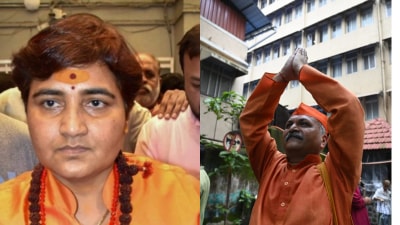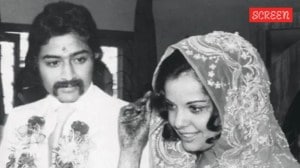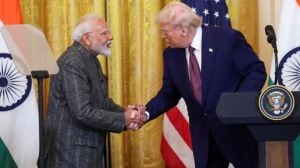Click here to follow Screen Digital on YouTube and stay updated with the latest from the world of cinema.
Guru: In a land where religious fanaticism and caste hatred run deep, this 1997 Malayalam film was, is and will continue to remain relevant
While the conversation surrounding “should cinema, or art in general, have a sense of responsibility” is very much alive, Rajiv Anchal’s Guru, a Malayalam film that raised many eyebrows, celebrated its 25th anniversary this year.
 A poster of Guru directed by Rajiv Anchal. (Source: Lainoj Reddesign)
A poster of Guru directed by Rajiv Anchal. (Source: Lainoj Reddesign) Photography is truth. The cinema is truth 24 times per second.
– Le Petit Soldat, 1960/63, Dir. Jean-Luc Godard
It is not often that Indian film audiences get to watch a movie that is a reflection of the society we live in. In fact, as popular film industries are so obsessed with mythology these days, contemporary Indian cinema is anything but the representation of truth/reality. Unfortunately, any attempt to not be a part of this wave is easily swept away by the strong currents of mindless content.
At a time like this, it may seem natural to look back at old films that were way ahead of their time in terms of discussing themes that are still relevant after decades.
While more and more people are voicing the opinion that “cinema, or art in general, should have a sense of responsibility”, especially in an era wherein religious fanaticism and caste hatred are gaining further ground, a Malayalam film that raised many eyebrows celebrated its 25th anniversary this year.
Directed by Rajiv Anchal, Guru, the first Malayalam film to be submitted by India for the Oscars under the Best International Feature Film category, is nothing short of a visual treat, especially because it vehemently follows the ‘show, don’t tell’ technique. Mohanlal, Suresh Gopi, Kaveri, Madhupal, Sithara, Murali, Sreenivasan, Charuhasan, Nedumudi Venu, Captain Raju, and Reena are just a few of its ensemble cast members. Ilaiyaraaja (music), S. Kumar (cinematography), T. Muthuraj (art direction), Pattanam Rasheed (makeup), S. B. Satheeshan (costume design), and editors B. Lenin and V. T. Vijayan were among the notable technicians who contributed to the film.
Religion 🔁 Power 🔁 Politics
Guru opens with a scene showing a large number of bodies lying on a road. In the background, a cop can be heard speaking to his superior officer over the phone, “We haven’t been able to ascertain the exact number of deaths… There are heaps of bodies here… It’s difficult to find the precise number of Hindus and Muslims who were killed…”
 Guru opens with a scene showing a large number of bodies lying on a road. (Screengrab)
Guru opens with a scene showing a large number of bodies lying on a road. (Screengrab)
We are soon introduced to an idyllic, fictional village in Kerala, Vallikodu, where members of all religions coexist harmoniously. In other words, it is an egalitarian land described in the Onam song “Maveli naadu vaanidum kaalam… Maanusharellarumonnu pole”, narrating the characteristics of Kerala under the regime of Dravidian Asura king Mahabali.
But communal tensions flare up in the village when a politician, seeking electoral gains, decides to cash in on an incident in which a kid wearing a skullcap entered a temple. Though the villagers decide to let it go, the politician sends his men to infiltrate Vallikodu and sow the seeds of hatred. Soon, their efforts turn ‘fruitful’ and the village starts burning.
 Actors Mohanlal (right) and Murali in one of the scenes from Guru. (Screengrab)
Actors Mohanlal (right) and Murali in one of the scenes from Guru. (Screengrab)
Despite the fact that it prides itself on its pluralism, particularly when it comes to secularism, and that the Constitution’s Preamble itself carries words such as secularism, democracy, and socialism, India has never been free of religious violence and the country has seen its fair share of violence motivated by religious hatred – from the 1969 Gujarat riots and 1984 anti-Sikh riots to the 2002 Gujarat riots, 2013 Muzaffarnagar riots, and 2020 Delhi riots.
In fact, the number of hate crimes has only gone up over the years. The country, between 2016 and 2020, reported 3,399 cases of communal or religious rioting, the Ministry of Home Affairs (MHA) informed the Lok Sabha in March this year.
The United States Department of State, in its 2021 Report on International Religious Freedom (IRF), stated that “attacks on members of religious minority communities, including killings, assaults, and intimidation, occurred throughout the year in India.”
Unfortunately, several politicians who call themselves Chowkidars of the people have frequently attempted to incite animosity through divisive politics in order to gain or hold onto power, rather than attempting to calm the situation or put a stop to the violence. According to an NDTV report from 2018, which it prepared after a data collection exercise, the use of hateful and divisive language by high-ranking politicians had increased by almost 500 per cent in the four years since the BJP came to power at the Centre.
Guru’s first act throws light on how certain netas enter the scene, spew hate, and incite violence for selfish deeds, even if civilians would like to brush aside an issue.
[Is] Religion the opium of the people?
Raghuraman (Mohanlal) is a youngster struggling to eke out a living, especially since no other member of his family has a full-time job. His father, a local Hindu temple priest, is often disgusted by Raghuraman’s lifestyle, as the latter has renounced his Brahmin title. When his father criticises Raghuraman for violating ‘Brahmanya’ by working as an unlicensed guide for foreign tourists, the latter responds, “Haven’t we already deceived many generations by evoking the word Brahmanya? I don’t want to be a Brahmin, but a human being.”
 Raghuraman argues with his father (Charuhasan) over his job. (Screengrab)
Raghuraman argues with his father (Charuhasan) over his job. (Screengrab)
Raghuraman is also the one who tells the Hindu village elders not to make a hue and cry about a kid wearing a skullcap entering the temple, as it would ignite communal strife.
But things begin to take a turn once the politician executes his master plan. Though Raghuraman fumes after learning that his father has been roughed up by a group of men wearing skullcaps (they too were the politician’s henchmen), he, however, pipes down, realising that it can only make the situation worse.
 The people of Vallikodu flee their village. (Screengrab)
The people of Vallikodu flee their village. (Screengrab)
Once Vallikodu becomes a hostile region, Raghuraman leads a large group of villagers, irrespective of their religious identities, out in search of a land where the fire hasn’t spread. But Raghuraman was wrong; the fire had already spread from within.
A group of bigots soon discover their hideout and incinerate all his people, leaving the youngster boiling with rage.
Thus, he too becomes a hatemonger, ready to go to any lengths to avenge the murder of his loved ones. But once the venom of hatred starts running through his veins, Raghuraman begins to believe that those belonging to ‘one particular community’ are the villains. He fails to see the larger picture. He becomes part of a militant group that is awaiting the right moment to attack a rehabilitation camp where a large number of Muslims have sought solace.
 Raghuraman breaks down in tears seeing the remains of his loved ones. (Screengrab)
Raghuraman breaks down in tears seeing the remains of his loved ones. (Screengrab)
This part of the movie elaborates on how religion can easily stupefy even sensible minds. Despite years of peaceful coexistence, the villagers couldn’t let go of even the slightest jolt to their belief systems, which in turn transformed them into bloodthirsty monsters, resulting in their tragic end.
Once the damage is done, can it be undone?
During one of his attempts to blow up the rehabilitation camp, Raghuraman almost lands in the police net. But he successfully manages to flee by jumping into a river. The youth is rescued by those living in a Guru’s Ashram. Assuming that the police might be looking for him, Raghuraman decides to stay there for a while.
The followers of the Guru work towards building a balanced society. Though the makers do not mention it explicitly, except for the usage of the name Santhigiri Ashram, the Guru being referred to in this movie is Navajyoti Sree Karunakara Guru (1927–1999), and director Rajiv Anchal has been a follower of him for decades now.
In one of the episodes of Safari TV‘s autobiographical show Charithram Enniloode, Anchal mentioned that it was Karunakara Guru who asked him to make a movie for the kids following his back-to-back hits, Butterflies (1993) and Kashmeeram (1994), in the early 90s. Guru, he said, was produced by the followers of Karunakara Guru under the banner of Janasammathi Creations. He has, in the past, admitted that he was trying to spread the message of Karunakara Guru through the film.
 Rajiv Anchal helmed Guru. (Facebook)
Rajiv Anchal helmed Guru. (Facebook)
As the film progresses, Raghuraman meets a few members of his militant group who also entered the Ashram disguised as refugees. A few days later, they all get orders from the top brass saying that the time to attack the rehabilitation camp has arrived.
While setting out on the mission, Raghuraman is stopped by Vaidehi (Sithara). One of the Guru’s main disciples, Vaidehi arrived there because she felt a calling from her master to prevent Raghuraman from committing the sin.
 Actors Mohanlal and Sithara in Guru. (Screengrab)
Actors Mohanlal and Sithara in Guru. (Screengrab)
Though she tries to thwart the youth’s attempt, he decides to go forward. She then asks him to pay tribute to Guru once before leaving. As soon as he touches the sacred Paduka of the Guru, Raghuraman gets teleported to another world — a world where everyone, except him, is blind.
The Country of the Blind
It is ironic and significant at the same time that Raghuraman is the only person who has ‘eyesight’ in a land of credulous people ruled by fanatics. Even the discussion on vision is an offence here. The rulers of the land are so notorious and narrow-minded that the first scene in this land is of a person, hailing from a lower caste, being executed for “uniting the oppressed to stand against the upper caste and instilling confidence among them that the good times, when everyone can see, will arrive one day.”
Anchal himself has previously acknowledged that this part of Guru was influenced by H G Wells’ short story The Country of the Blind.
This nowhereland’s environment is both beautiful and rugged at once, and it effectively expresses the ethos of the country without the need for further explanation. Shot completely in and around an abandoned magnesite mine located near Yercaud in Tamil Nadu, the art and costume departments deserve all the appreciation for the scenes here as they created an exquisite parallel world with the utmost focus on detailing. From the houses that the people live in and the clothes they wear to the tools they use and their musical instruments, the technicians put their hearts into making them so fantastical.
The decision to extensively use dusty brown colour deserves special appreciation. It clearly highlights how the land is pretty monochromatic, as there is only one constant emotion in the people, and that is fear, and that the country kind of lives in the past, wherein superstitions rule all. One can find splashes of green only in a few places.
 King Vijayanta’s palace. (Screengrab)
King Vijayanta’s palace. (Screengrab)
Though the original musical score and songs were composed by Ilaiyaraaja, the Budapest Symphony Orchestra in Hungary conducted and performed his symphonic score. According to Anchal, Ilaiyaraaja took this decision so that he could combine the native music with some of Hungary’s distinctive and previously unheard tunes to give viewers a full sense that the events were taking place in a fictional realm.
While exploring the country, Raghuraman meets a man named Ramanagan (Madhupal) who belongs to an oppressed community. Though Raghuraman tries to tell him that he has eyesight, Ramanagan refuses to believe it, as no one he knows of has that ‘power’. But, Ramanagan starts believing Raghuraman when the latter helps him get into the palace of King Vijayanta and go near his lover, Princess Syamantaga (Kaveri), which Ramanagan believes only a person with eyesight can do.
 Actor Madhupal as Ramanagan. (Screengrab)
Actor Madhupal as Ramanagan. (Screengrab)
Raghuraman, albeit still unclear as to what his purpose in that land is, starts looking around to find the reason behind everyone’s blindness. In the meantime, he realises that his fight is not just against the King and the army but against the foundation of their parochial belief system itself.
 Actor Suresh Gopi as King Vijayanta. (Screengrab)
Actor Suresh Gopi as King Vijayanta. (Screengrab)
Meanwhile, King Vijayanta (Suresh Gopi) learns about Raghuraman who is ‘spreading lies’ among the people about eyesight. A furious Vijayanta orders his army to capture both the ‘devil’ and his aide Ramanagan. The two soon go into hiding.
It is then that Raghuraman learns about a fruit that grows in the valleys. “If a kid is not fed the extract of Ilama fruit soon after birth, they won’t live long enough. It’s a medicine that has been passed down through generations. But never eat its seed, it’s deadly,” Ramanagan tells Raghuraman.
 Actor Kaveri as Princess Syamantaga. (Screengrab)
Actor Kaveri as Princess Syamantaga. (Screengrab)
By now, it should be clear that the Ilama fruit represents religion. It is also possible to interpret the giving of the fruit to babies as a commentary on the prevalence of forcing religious instruction on children without their knowledge or consent. These children are given membership cards to join their parents’ religion before they are mature enough to make an informed choice, and then they are pressured to adhere to the laws, beliefs, and traditions that have been established by those in authority.
Raghuraman becomes addicted to the fruit the moment he tastes it. But, minutes after eating a few Ilama fruits, Raghuraman loses his eyesight, making him realise that this so-called life-saving fruit was the actual reason behind their blindness.
 Raghuraman tastes Ilama fruit for the first time. (Screengrab)
Raghuraman tastes Ilama fruit for the first time. (Screengrab)
Raghuraman, helpless and unsure of where to go or how to regain his sight, runs around the land, warning people about the fruit. But he soon falls into the army’s net and the King awards him the death penalty. As he tried to ‘slander’ the ‘divine’ fruit, the King directs his men to kill Raghuraman by feeding him the poisonous seed of the Ilama fruit. The army executes him, just as the king desired.
But their calculations went wrong; not only did Raghuraman not die, but he also regained his sight. Yes, the seed was the antidote to the fruit!
The metaphorical images in the movie reach another level here. While the fruit represents religion, which although the elders say helps make the world a better place but is actually doing the exact opposite by spreading hate, the seed stands as a symbol of the ultimate truth and love – or, as people like to call it, God. The truth hidden in plain sight!
Thus, Raghuraman realises his purpose – he was sent there to lead an entire clan of people blinded by superstitions and bigotry, towards light by feeding them the seed of truth. He, whose real-world self is driven by bloodlust, becomes the Guru here.
The film ends by showing Raghuraman waking up from the transcendental state and realising that his world too is blind. “I don’t want to kill anyone… I don’t hate anyone…” says the changed man as he runs to save those who are being attacked by the men of his squad. Though the militants had already massacred many in the rehabilitation camp by the time Raghuraman reached there, he successfully saves a large number of kids. He leads them out, hopefully towards the light, the truth and a better tomorrow.
 Raghuraman rescues children from the rehabilitation camp. (Screengrab)
Raghuraman rescues children from the rehabilitation camp. (Screengrab)
Is Guru one of the greatest Malayalam movies ever? Absolutely not!
Guru, just like any other movie, is not flawless. From the (un/intentional) glorification of ableism and appropriation of a disability to religious fanaticism to the overreliance on the notion that spirituality is the solution to everything evil in society, the movie failed on multiple levels. It was not a commercial success either.
Despite its portrayal as a place that imparts the ultimate wisdom, there’s a scene in the movie wherein a group of women read out one of the writings by the Guru and then discuss how an ‘ideal’ woman should be. And (un)surprisingly, it relies solely on the age-old regressive societal norms. This scene proved patriarchy is so ingrained that even during discussions on equality, women are last among equals.
Though Raghuraman cannot be seen as a person with saviour complex, the fact that he too, at the end of the day, is a Brahmin, reinforces the popular narrative that ‘only a Brahmin can lead the path towards paradise’.
However, as the environment is becoming more hostile and self-proclaimed artists are conveniently silent, it is only fitting to revisit films such as Guru that bravely addressed several social issues and inadvertently foretold the future.


Photos
Photos



- 01
- 02
- 03
- 04
- 05





























